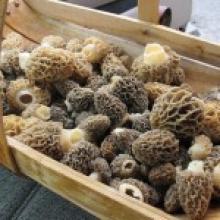It may be helpful to understand the ecology of mushrooms before you get started hunting your own, or even growing them. A mushroom itself is a fruiting body, kind of like the acorn of an oak tree. The fungi itself (the tree trunk) is often hidden from our eyes either in the soil or the trunk of a rotting tree. Sometimes you can find them; they may appear as long, white, interconnected strands. Those strands are finding the nutrients needed to keep them growing. When conditions are right (usually a combination of day length, humidity, and heat), they will produce a mushroom.
I might be slightly biased when it comes to choosing the topic for this month’s blog entry, so I’ll admit it. I love mushrooms. Last summer my brother collected enough morel mushrooms to leave any mushroom lover drooling. But he lives in Idaho, so no, you can’t have his secret spot. And that is the reason for this article. When it comes to mushrooms, you have two choices. You can collect mushrooms from your land, or you can grow them on your property. And of course, you can have them for your own consumption (luckily my brother learned to share at a young age) or you can sell them and get a pretty penny too.
It may be helpful to understand the ecology of mushrooms before you get started hunting your own, or even growing them. A mushroom itself is a fruiting body, kind of like the acorn of an oak tree. The fungi itself (the tree trunk) is often hidden from our eyes either in the soil or the trunk of a rotting tree. Sometimes you can find them; they may appear as long, white, interconnected strands. Those strands are finding the nutrients needed to keep them growing. When conditions are right (usually a combination of day length, humidity, and heat), they will produce a mushroom. Back to the acorn concept, the mushroom’s primary purpose is to produce seeds, in this case, spores, to facilitate regeneration of the fungi. Without getting too scientific, there are specific types of fungi that coexist quite nicely with certain trees in our forests and produce nice mushrooms. In other words, if your woods has pine, hemlock, fir, spruce, beech, oak, birch, or aspen trees, start hunting. If you are in a maple dominated woods, you might want to look elsewhere. Some mushrooms are specific to certain trees. For example, morels are associated with dead/dying elms and apple trees. Hen of the woods are often associated with oaks trees.
If your plan is to go around collecting mushrooms, the first must is a course in mushroom identification or collecting with a long-time collector. Although there are many tasty treats out there, make just one wrong choice, and the results could be fatal. The Wisconsin Mycological Society hosts events for members and may be a good place to start. They offer lectures on mushrooms and lead collecting trips. Some of the more common mushrooms people hunt for in Wisconsin include: morels, hen of the woods, chanterelle and oyster. When you pick mushrooms, leaving the fungi intact will encourage growth of future mushrooms. This way you are picking the acorn, rather than cutting down the whole tree.
If you are interested in growing mushrooms, there are a growing number of options out there for you. The two main things you will need include fresh-cut logs and the mushroom spores. It is recommended that you cut the logs no more than a few days prior to inoculation. This is so you don’t get other unwanted fungi growing on there before you inoculate them. The best type of trees to cut will depend on the type of mushrooms you will be growing. You can buy the spores online, either as plugs (or dowels) or sawdust spawn. A quick search online came across over a dozen hits for shiitake plugs.
As spring is right around the corner, now is the time to start thinking mushrooms. Personally, this article has me dreaming of the first morels and ramps. Nature grows them together, so I’ll eat them together.
